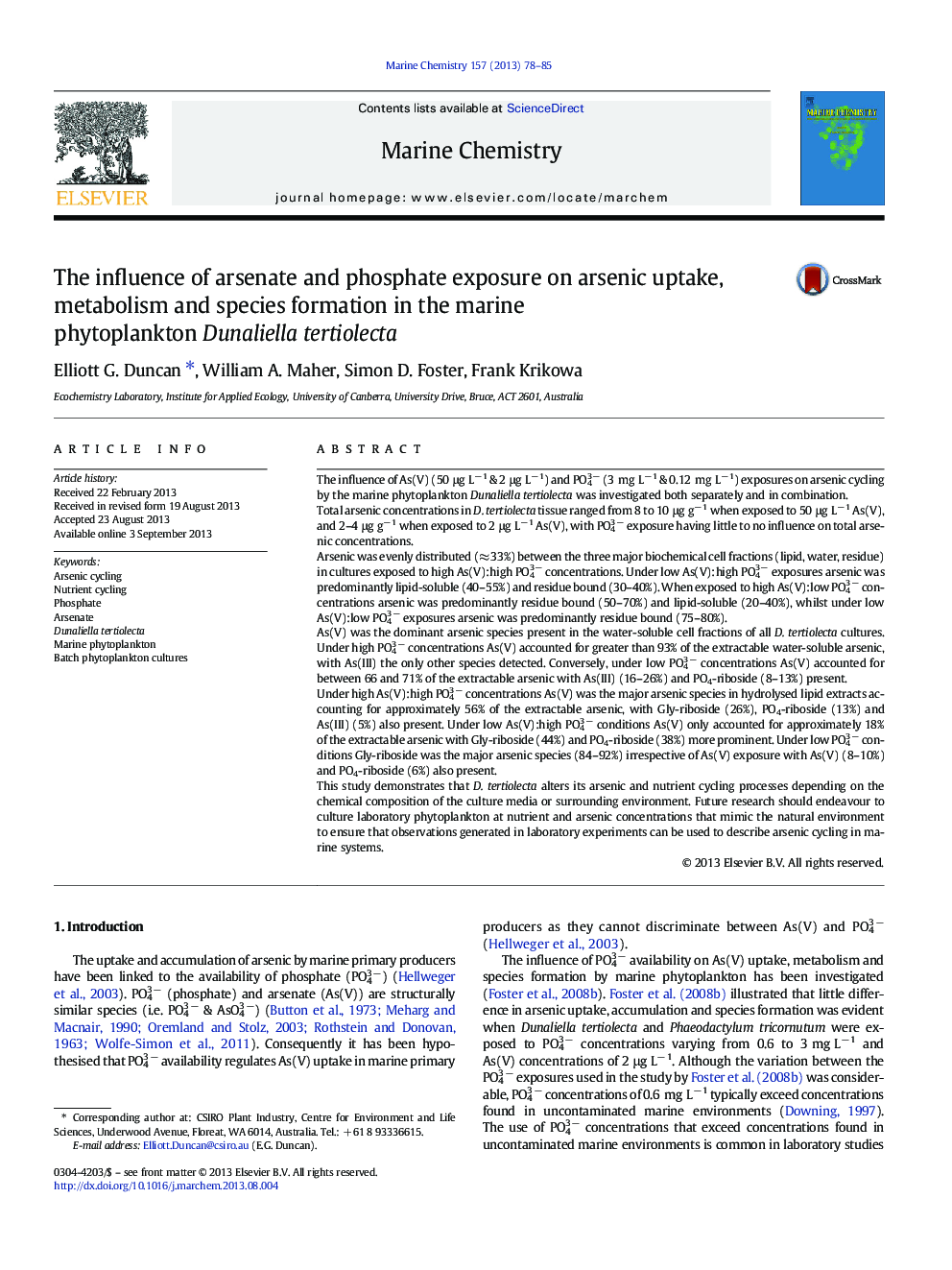| کد مقاله | کد نشریه | سال انتشار | مقاله انگلیسی | نسخه تمام متن |
|---|---|---|---|---|
| 1262998 | 1496678 | 2013 | 8 صفحه PDF | دانلود رایگان |

• PO43 − exposure influences arsenic cycling by Dunaliella tertiolecta.
• As(V) exposure influences total arsenic concentrations.
• As(V) and PO43 − concentrations are of more importance than As(V):PO43 − ratios.
• D. tertiolecta alters arsenic cycling behaviour depending on the environment.
The influence of As(V) (50 μg L− 1 & 2 μg L− 1) and PO43 − (3 mg L− 1 & 0.12 mg L− 1) exposures on arsenic cycling by the marine phytoplankton Dunaliella tertiolecta was investigated both separately and in combination.Total arsenic concentrations in D. tertiolecta tissue ranged from 8 to 10 μg g− 1 when exposed to 50 μg L− 1 As(V), and 2–4 μg g− 1 when exposed to 2 μg L− 1 As(V), with PO43 − exposure having little to no influence on total arsenic concentrations.Arsenic was evenly distributed (≈ 33%) between the three major biochemical cell fractions (lipid, water, residue) in cultures exposed to high As(V):high PO43 − concentrations. Under low As(V):high PO43 − exposures arsenic was predominantly lipid-soluble (40–55%) and residue bound (30–40%). When exposed to high As(V):low PO43 − concentrations arsenic was predominantly residue bound (50–70%) and lipid-soluble (20–40%), whilst under low As(V):low PO43 − exposures arsenic was predominantly residue bound (75–80%).As(V) was the dominant arsenic species present in the water-soluble cell fractions of all D. tertiolecta cultures. Under high PO43 − concentrations As(V) accounted for greater than 93% of the extractable water-soluble arsenic, with As(III) the only other species detected. Conversely, under low PO43 − concentrations As(V) accounted for between 66 and 71% of the extractable arsenic with As(III) (16–26%) and PO4-riboside (8–13%) present.Under high As(V):high PO43 − concentrations As(V) was the major arsenic species in hydrolysed lipid extracts accounting for approximately 56% of the extractable arsenic, with Gly-riboside (26%), PO4-riboside (13%) and As(III) (5%) also present. Under low As(V):high PO43 − conditions As(V) only accounted for approximately 18% of the extractable arsenic with Gly-riboside (44%) and PO4-riboside (38%) more prominent. Under low PO43 − conditions Gly-riboside was the major arsenic species (84–92%) irrespective of As(V) exposure with As(V) (8–10%) and PO4-riboside (6%) also present.This study demonstrates that D. tertiolecta alters its arsenic and nutrient cycling processes depending on the chemical composition of the culture media or surrounding environment. Future research should endeavour to culture laboratory phytoplankton at nutrient and arsenic concentrations that mimic the natural environment to ensure that observations generated in laboratory experiments can be used to describe arsenic cycling in marine systems.
Journal: Marine Chemistry - Volume 157, 20 December 2013, Pages 78–85